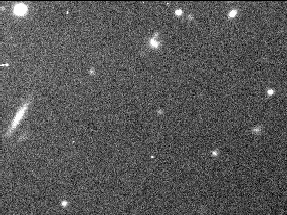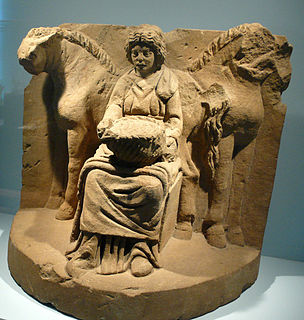
The Celtic languages are a group of related languages descended from Proto-Celtic. They form a branch of the Indo-European language family. The term "Celtic" was first used to describe this language group by Edward Lhuyd in 1707, following Paul-Yves Pezron, who made the explicit link between the Celts described by classical writers and the Welsh and Breton languages.

In Gallo-Roman religion, Cernunnos was a deity depicted with antlers, seated cross-legged, and is associated with stags, horned serpents, dogs, bulls, and rats. He is usually holding or wearing a torc and has been seen holding a bag of coins and a cornucopia. Believed to have originally been a Celtic deity, over 50 examples have been found from this time believed to be associated with him, concentrating in the north-eastern region of what was called Gaul by the ancient Romans. Cernunnos is also associated with the Wiccan Horned God in the modern religious tradition of Wicca.
Alaunus or Alaunius is a Gaulish god of healing and prophecy. His name is known from inscriptions found in Lurs, Alpes-de-Haute-Provence in southern France and in Mannheim in western Germany. In the latter inscription, Alaunus is used as an epithet of Mercury. The feminine form Alauna is at the origin of many place-names and hydronyms across Europe, including the Roman-era names of Valognes in Normandy, Maryport and Watercrook in Cumbria, Alcester in Warwickshire, Ardoch in Perthshire, and Learchild and the River Aln in Northumberland.
Gofannon is a Middle Welsh reflex of Gobannus, one of the deities worshipped by the ancient Celts. He features in Middle Welsh literature as a great metal worker and as the son of Dôn. His name can be compared with the Old Irish gobae ‘smith’, Middle Welsh gof ‘smith’, Gaulish gobedbi ‘with the smiths’, all of which are cognate with Lithuanian gabija ‘sacred home fire’, gabus ‘gifted, clever’. His apparent counterpart in Irish mythology, Goibniu, in addition to his duties as a smith, also takes on the role of a divine hero who brewed an ale of immortality, in addition to being an architect and builder.
Ogma is a god from Irish and Scottish mythology. A member of the Tuatha Dé Danann, he is often considered a deity and may be related to the Gallic god Ogmios. According to the Ogam Tract, he is the inventor of Ogham, the script in which Irish Gaelic was first written.

Esus, Hesus, or Aisus was a Gaulish god known from two monumental statues and a line in Lucan's Bellum civile.

Grannus was a Celtic deity of classical antiquity. Based on the etymology of his name, Grannus may have been associated with spas, thermal springs, and the sun; having bushy hair, beard and/or eyebrows; or having a connection with the concept of shining/gleaming. He was regularly identified with Apollo as Apollo Grannus. He was frequently worshipped in conjunction with Sirona, and sometimes with Mars and other deities.

Lugus was a deity of the Celtic pantheon. His name is rarely directly attested in inscriptions, but his importance can be inferred from place names and ethnonyms, and his nature and attributes are deduced from the distinctive iconography of Gallo-Roman inscriptions to Mercury, who is widely believed to have been identified with Lugus, and from the quasi-mythological narratives involving his later cognates, Welsh Lleu Llaw Gyffes and Irish Lugh Lámhfhada.

In ancient Celtic religion, Maponos or Maponus is a god of youth known mainly in northern Britain but also in Gaul. In Roman Britain, he was equated with Apollo.

In Celtic mythology, Taranis or Taranus is the god of thunder, who was worshipped primarily in Gaul, Gallaecia, Britain, and Ireland but also in the Rhineland and Danube regions, amongst others. Taranis, along with Esus and Toutatis as part of a sacred triad, was mentioned by the Roman poet Lucan in his epic poem Pharsalia as a Celtic deity to whom human sacrificial offerings were made. Taranis was associated, as was the Cyclops Brontes ("thunder") in Greek mythology, with the wheel.

Tarvos, or Saturn XXI, is a prograde irregular satellite of Saturn. It was discovered by John J. Kavelaars et al. on September 23, 2000, and given the temporary designation S/2000 S 4. The name, given in August 2003, is after Tarvos, a deity depicted as a bull god carrying three cranes alongside its back from Gaulish mythology.

The Gundestrup cauldron is a richly decorated silver vessel, thought to date from between 200 BC and 300 AD, or more narrowly between 150 BC and 1 BC. This places it within the late La Tène period or early Roman Iron Age. The cauldron is the largest known example of European Iron Age silver work. It was found dismantled, with the other pieces stacked inside the base, in 1891 in a peat bog near the hamlet of Gundestrup in the Aars parish of Himmerland, Denmark. It is now usually on display in the National Museum of Denmark in Copenhagen, with replicas at other museums; during 2015–16 it was in the UK on a travelling exhibition called The Celts.
In Celtic mythology, the Otherworld is the realm of the deities and possibly also of the dead. In Gaelic and Brittonic mythology it is usually described as a supernatural realm of everlasting youth, beauty, health, abundance and joy. The Otherworld is similar to the parallel universe, usually elusive, but various mythical heroes visit it either through chance or after being invited by one of its residents. They often reach it by entering ancient burial mounds or caves, or by going under water or across the western sea. Sometimes, the Otherworld is said to exist alongside our own located beyond the edge of the earth and intrudes into our world; signalled by phenomena such as magic mist, sudden changes in the weather, or the appearance of divine beings or unusual animals. An otherworldly woman may invite the hero into the Otherworld by offering an apple or a silver apple branch, or a ball of thread to follow as it unwinds.
The Pillar of the Boatmen is a monumental Roman column erected in Lutetia in honour of Jupiter by the guild of boatmen in the 1st century AD. It is the oldest monument in Paris and is one of the earliest pieces of representational Gallo-Roman art to carry a written inscription.

Ancient Celtic religion, commonly known as Celtic paganism, comprises the religious beliefs and practices adhered to by the Iron Age people of Western Europe now known as the Celts, roughly between 500 BCE and 500 CE, spanning the La Tène period and the Roman era, and in the case of the Insular Celts the British and Irish Iron Age. Very little is known with any certainty about the subject, and apart from documented names, which are thought to be of deities, the only detailed contemporary accounts are by hostile Roman writers, who were probably not well-informed.
Cicolluis or Cicoluis is a god in Celtic mythology worshiped by the ancient Gaulish peoples and having a parallel in Ireland. The name is Gaulish and means “All-Breast” or “Great-Breasted” and is probably used to signify strength. In the Gallo-Roman religion, Cicolluis is thought to be a common epithet for Gaulish Mars. A Latin dedicatory inscription from Narbonne, France, bears the words MARTI CICOLLUI ET LITAVI ., “Mars Cicolluis” has dedications in Xanten, Germany, and Aignay-le-Duc and Mâlain of the Côte-d'Or, France. “Cicolluis” is named alone in an inscription at Chassey, Côte-d'Or, Franche-Comté, France, and a partial inscription from Ruffey-lès-Echirey, Côte-d'Or, France, may be dedicated to Cicolluis. In Windisch, Switzerland, he is known as “Cicollus,” and in Dijon, Côte-d'Or, France, he is known as “Mars Cicoluis.”
According to classical sources, the ancient Celts were animists. They honoured the forces of nature, saw the world as inhabited by many spirits, and saw the Divine manifesting in aspects of the natural world.

The gods and goddesses of the pre-Christian Celtic peoples are known from a variety of sources, including ancient places of worship, statues, engravings, cult objects and place or personal names. The ancient Celts appear to have had a pantheon of deities comparable to others in Indo-European religion, each linked to aspects of life and the natural world. By a process of syncretism, after the Roman conquest of Celtic areas, these became associated with their Roman equivalents, and their worship continued until Christianization. Pre-Roman Celtic art produced few images of deities, and these are hard to identify, lacking inscriptions, but in the post-conquest period many more images were made, some with inscriptions naming the deity. Most of the specific information we have therefore comes from Latin writers and the archaeology of the post-conquest period. More tentatively, links can be made between ancient Celtic deities and figures in early medieval Irish and Welsh literature, although all these works were produced well after Christianization.

Celtic is the mythology of Celtic polytheism, the religion of the Iron Age Celts. Like other Iron Age Europeans, the early Celts maintained a polytheistic mythology and religious structure. For Celts in close contact with Ancient Rome, such as the Gauls and Celtiberians, their mythology did not survive the Roman Empire, their subsequent conversion to Christianity and the loss of their Celtic languages. It is mostly through contemporary Roman and Christian sources that their mythology has been preserved. The Celtic peoples who maintained either political or linguistic identities left vestigial remnants of their ancestral mythologies that were put into written form during the Middle Ages.










